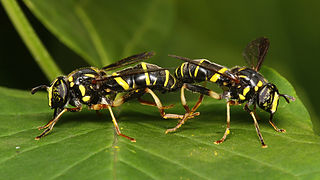
Euconocephalus is a genus of bush cricket in the 'conehead' tribe Copiphorini.

Xylota is a Holarctic genus of hoverflies similar in structure to the related genera Chalcosyrphus and Brachypalpoides. As the larvae are saprophytic they're usually found in rotting wood. The adult flies are generally associated with woodland and woodland edges and can often be seen running over the upper sides of leaves. Unlike other syrphids the adults of many species rarely visit flowers preferring instead to gather pollen from leaf surfaces. There are over 100 described species of which 12 can be found in Europe. Seven species have been recorded in Britain. Identification of species has been difficult and identifiction by photographs is risky.

Spilomyia is a genus of hoverflies. Many species in the genus show Batesian mimicry of wasp models, including black and yellow patterns and modified antenna shape.

Cheilosia is a genus of hoverfly. Most Cheilosia are black or largely un-coloured, lacking the bright colours and patterns of many hoverfly species. It is one of the most species diverse genera of hoverflies. The biology of many species is little understood, but where known, the larvae of Cheilosia species feed in the stems of plants or in fungi.

Acromantis is a genus of Asian praying mantids in the subfamily Acromantinae of the family Hymenopodidae.

Urophora is a genus of tephritid or fruit flies in the family Tephritidae.

Melanostoma is a large genus of hoverflies. Little is known of their biology, but they are suspected to be general predators of small insects in leaf litter.

Criorhina is a genus of hoverflies. Medium to large sized species, black or greenish black, with or without light ground markings mimicking bumblebees. The head is much flattened and broader than the thorax. The antennae are situated upon a prominent conical frontal process, The face is moderately produced below the eyes, downward or forward, in profile. The eyes are bare. The abdomen is elliptical or very short oval. Larvae found in rot holes or decaying hardwoods

Blera is primarily a North American genus, though there are 3 species from Europe. The genus is characterized by the following characters:
Citrogramma is a genus of hoverfly.
Sinochlora is a genus of Asian bush crickets of the tribe Holochlorini within the subfamily Phaneropterinae. Species have been recorded from China, Taiwan, Korea, Japan, and Vietnam.

Kuzicus is a genus of Asian bush crickets belonging to the tribe Meconematini in the subfamily Meconematinae.
Palaeoagraecia is an Asian genus of bush crickets in the tribe Agraeciini, belonging to the 'conehead' subfamily Conocephalinae. Species have been recorded from Bangladesh, China, Korea, Japan, Indo-China, Malesia, New Guinea and western Pacific islands.
Neanias is a genus of Orthopterans, sometimes known as 'leaf-folding crickets' in the subfamily Gryllacridinae and tribe Gryllacridini. The recorded distribution is: Indian subcontinent, Japan, Hainan, Indochina, and western Malesia (Sumatra).
Criorhina japonica is a species of hoverfly in the family Syrphidae.
Matsumyia is a genus of hoverfly in the family Syrphidae.
Milesia yaeyamana is a species of hoverfly in the family Syrphidae.
Eugryllacris is a genus of Orthopterans, sometimes known as 'leaf-folding crickets' in the tribe Gryllacridini. The recorded distribution is: the Indian subcontinent, China, Korea, Japan, Indochina, western Malesia up to the Maluku Islands.










